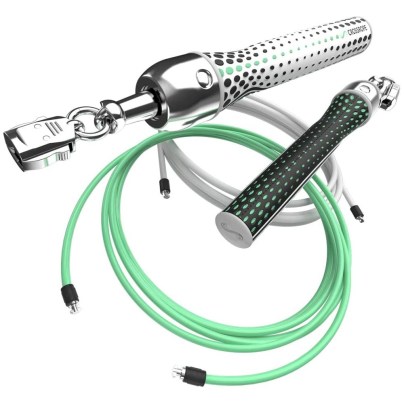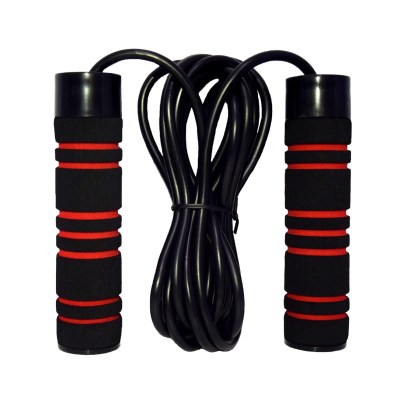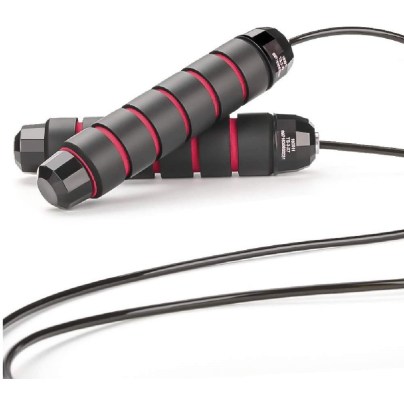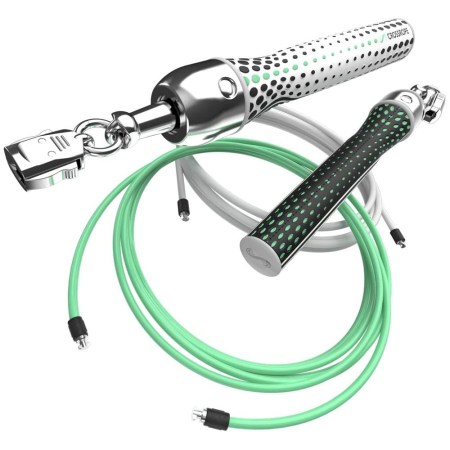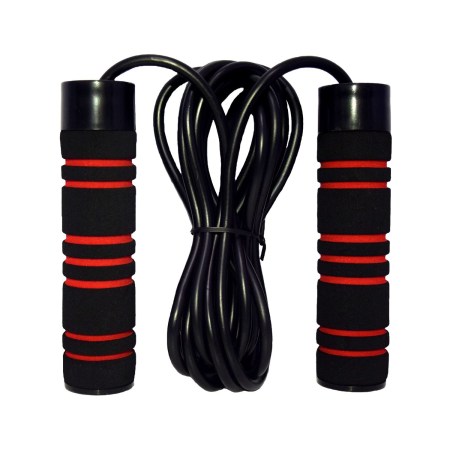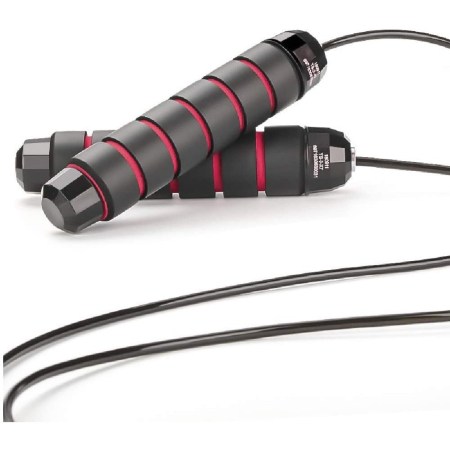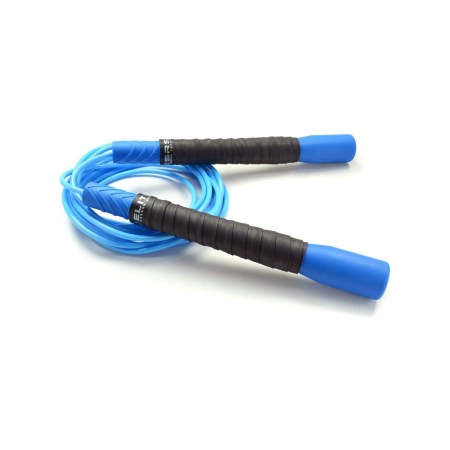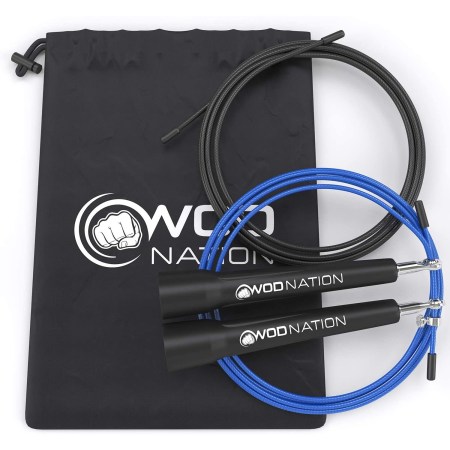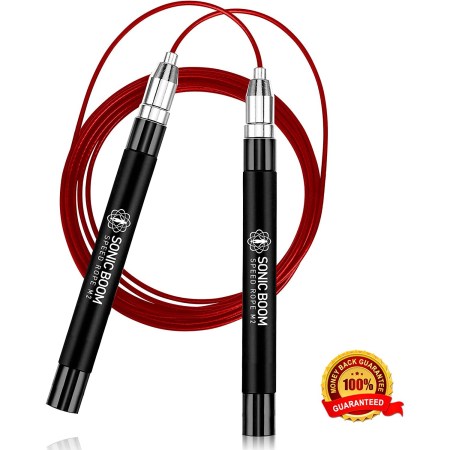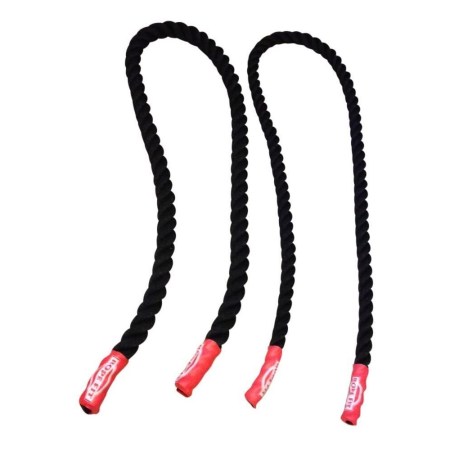We may earn revenue from the products available on this page and participate in affiliate programs. Learn More ›
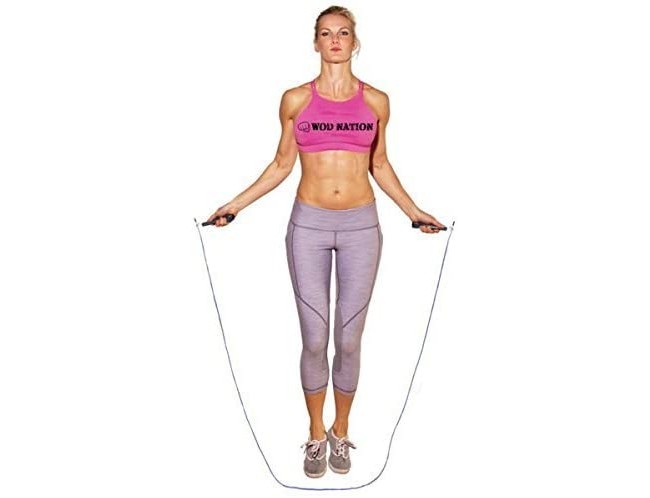
Although jumping rope is a classic for fitness conditioning and weight loss, it might be the most underrated workout around. Many of us haven’t skipped rope since grade school. But jumping rope has value beyond the playground. Research shows that 10 minutes of jumping rope is roughly the equivalent of running an eight-minute mile, but with less impact on the knees.
Jumping rope can improve cardiovascular health, achieve overall body toning, increase concentration, improve balance and coordination, and improve mental health. You can skip rope anywhere: at home, in a gym, or in a hotel room if you travel for work.
Jump ropes have gotten specialized, and they’re engineered to target specific fitness goals. The best jump ropes have features like steel-coated cable, handles with ball bearings, or weighted handles.
To find a jump rope for your workouts, decide on your goals—weight loss, strength, or agility—and choose a rope with the features you need to reach those goals. Read on for reviews of some of the best jump ropes.
- BEST OVERALL: Crossrope Get Lean Weighted Jump Rope Set
- RUNNER-UP: Weighted Jump Rope by Pulse
- BEST BANG FOR THE BUCK: DEGOL Skipping Rope
- BEST FOR BEGINNERS: EliteSRS Beginner Jump Rope for Adults
- BEST FOR SPEED WORK: WOD Nation Speed Jump Rope
- BEST FOR DOUBLE UNDERS: Sonic Boom M2 High Speed Jump Rope
- BEST WEIGHTED: RopeFit Heavy Jump Rope
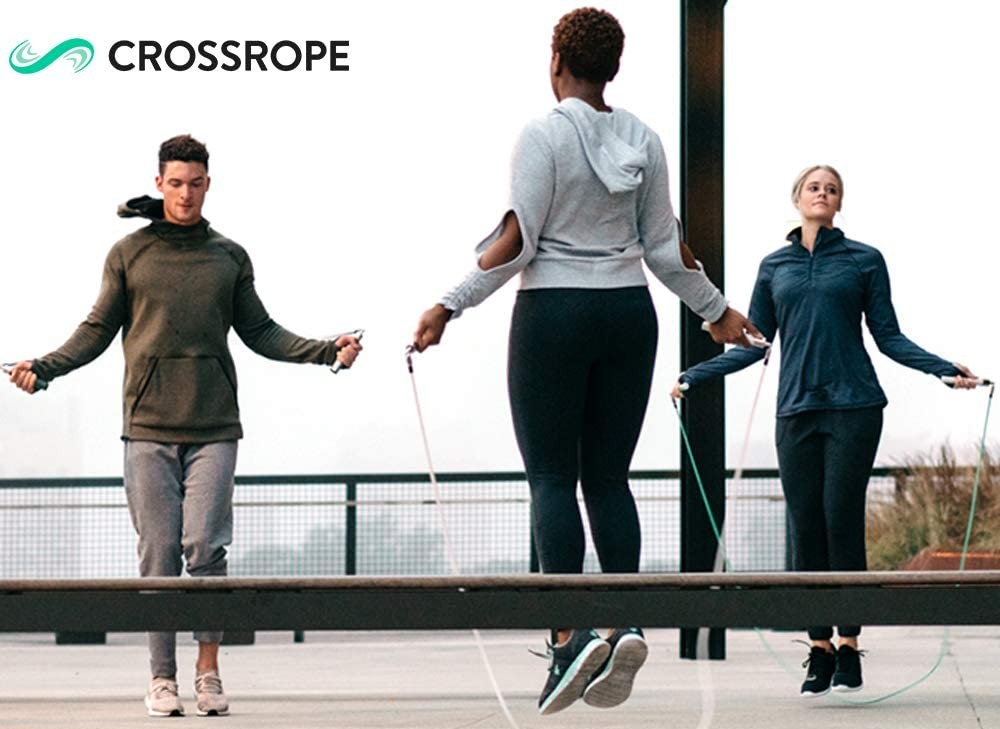
Types of Jump Ropes for Athletics
There are four types of jump ropes: basic, speed, weighted, and beaded.
Basic
Basic jump ropes are made for beginners. They’re usually the least expensive type, but they still provide a good workout. Basic jump ropes are thicker and heavier than speed ropes but lighter than weighted jump ropes. Most are made of plastic, with handles of rubber or foam.
Speed
Speed jump ropes are lightweight and made to let you jump rope fast for maximum calorie burning. They’re usually made with a thin cord and have ball bearings in the handles so the rope can spin fast. Speed ropes are for more advanced users who are looking to blast body fat or target a particular part of the body by doing technical moves like crisscrosses or double unders.
Weighted
Weighted jump ropes give your arms and shoulders a workout. They have extra weight—generally 1 to 6 pounds—integrated into the handles or the cable. The extra weight makes you exert more energy, so you get a more vigorous workout that builds strength as well as burning fat. Weighted ropes are usually aimed at experienced jumpers, but beginners can use them, too. Weighted ropes are slower than speed ropes, so a new jumper can focus on coordination, timing, and form.
Beaded
Beaded ropes, also known as segmented jump ropes, have a nylon or steel inner cord encased in plastic beads. The rope’s not heavy, but the beads add some weight to the rope. Beaded ropes are thicker and slower, so they’re good for warm-ups before you tackle double-under sets or speed work with a speed rope. Most beaded ropes are tangle-free and adjustable.
What to Consider When Choosing the Best Jump Rope
When shopping for the best jump rope for you, there are several factors to consider.
Intended Use
Pick a jump rope based on how and where you will be using it. Will you skip rope indoors or outdoors? Do you want a jump rope that’s designed for cardio training, or are you looking to add a different warm-up to your workout? If you’ll be jumping on concrete, you may want to skip a beaded rope because those plastic beads can’t stand up to the whacking they’ll get. If you want to build upper-body strength, consider a weighted rope. If burning calories and losing weight is your goal, a speed rope may be the most suitable jump rope for you.
Jump ropes are a good way to do high-intensity interval training (HIIT,) a term for workouts that combine short bursts of intense exercise with periods of rest of lower-intensity exercise. HIIT is touted as a way to build cardio strength, improve lung capacity, and burn fat in a fraction of the time, making it good for those of us who cannot spend all day in a gym.
Experience Level
Pick a jump rope that matches your jumping experience. Competitive jumpers often prefer speed ropes with steel cables because they’re lightweight and have an efficient spin. Speed ropes require skill and coordination and are not for jump-rope newbies. Nylon or PVC ropes are the best jump ropes for beginners working on form and control.
Jump ropes designed for weight loss and cardio training are typically suitable for all levels of experience. If you haven’t jumped rope since you were 10 and don’t know a double under from a side swing, a basic jump rope with no bells and whistles may be the best rope for you.
Cord Thickness
A jump rope’s thickness varies with its function. Ropes (cords) recommended for beginners and cardio enthusiasts have thicker cables to slow movement or add weight. Thicker cables are also good for strength-building and weight loss. If you’re experienced at skipping rope and want to jump fast and do fancy moves that build agility, a thinner (and lighter) steel cable may be the best jump rope for you. Steel cables reduce friction, so you can jump a lot faster.
Comfort Handles
Handles come in plastic, leather, foam, and aluminum. A comfortable handle will affect your jumping experience, so choose wisely. Ergonomic designs with contour grips are good for long sessions of skipping. Longer handles (more than 6 inches) are better than shorter ones. If the handle is too short, you run the risk of catching your knuckles on the cable or having the handle slip out of your hands. Plastic, hollow handles are not good for achieving a controlled spin, and they’re hard to hang on to with sweaty hands. Look for handles with sturdy, comfortable grips that wick moisture.
Size Adjustment
The jump-rope length you need depends on your skill level. Here’s how to calculate the length that’s best for you: Multiply your height by three, then add some length for head clearance. The less skilled you are, the more clearance you need so you don’t hit yourself in the head. Beginners should add 8 to 12 inches. Intermediate jumpers should add 4 to 7 inches, and advanced jumpers should add 1 to 2 inches.
Most jump ropes are adjustable. Some allow for a one-time adjustment that is permanent, while other ropes allow for repeated adjustment. That’s a nice feature if you’re going to share the rope with family members or use it in a community space.
Versatility
While some high-end jump ropes are made for specific training purposes, others can meet a range of goals. Some ropes come with interchangeable cables for those looking for both speed and strength training. Some jump ropes have adjustable lengths, too, so you can shorten the rope as your skills improve. Smart ropes add a digital twist to your rope jumping by digitally displaying data on the handle, allowing you to monitor your stats or duration in real time.
Our Top Picks
We reviewed some top-performing jump ropes, measured them against our buying considerations, and picked some favorites.
Best Overall
Crossrope Get Lean Weighted Jump Rope Set
See ItCrossrope’s Get Lean set offers two weighted jump-rope weights—a ½-pound rope for cardio and a ¼-pound one for endurance training, speed training, or HIIT. The rope’s weight options make it a good choice if you alternate your cardio approach between low and high intensities. The ropes are easily interchangeable and don’t tangle when in motion. The handles are slim and ergonomic with a soft, moisture-resistant grip. Crossrope includes a mobile app, giving you access to tutorials, workouts, and fitness challenges. The Crossrope comes in four lengths, so you can choose the one that’s right for your height.
Runner-Up
Weighted Jump Rope by Pulse
See ItThe Pulse’s Weighted Jump Rope can be used for cardio or speed training, so its versatility makes it our No. 2 pick. It’s a simple, sturdy rope for a great price. The comfortable foam handles and 6-millimeter PVC rope give a smooth workout. The rope’s length can be adjusted for your height and fitness goals, but once you make the adjustment, it’s permanent.
Pulse’s rope can handle a beating from pavement and other hard surfaces, so it’s a good choice if you skip rope outdoors. The handles have removable ½-pound weights so you can vary your workout, and their ball-bearing mechanisms keep rope rotations smooth and tangle-free.
Best Bang For The Buck
DEGOL Skipping Rope
See ItThe Degol’s lightweight design and affordable price make this piece of equipment a good addition to your cardio program. The braided steel wire rope is coated with PVC for durability, and it has an anti-tangle design with a ball-bearing system for speed. It’s 6-inch long handles are wrapped in soft memory foam so you can get a good, comfortable grip. It comes with a 9-foot length of cable that you can adjust for your height. The Degol is a good option for first-time jumpers who want to try a new exercise without spending a lot.
Best For Beginners
EliteSRS Beginner Jump Rope for Adults
See ItIf you want to add skipping rope to your fitness routine, the EliteSRS Beginner Jump Rope is a good choice for a beginner. Its lightweight, extra-long, 8-inch handles let you jump without exhausting your upper body, and its PVC cord doesn’t kink or coil. The 4-millimeter-diameter cord is light enough that you can skip faster as your skills improve.
Its 10-foot-long cord is adjustable, but once you shorten it, the length is permanent, so the EliteSRS is not good for use as a shared rope. Its interchangeable cable lets you start with a heavier cable (included) and transition to a lighter cable (purchased separately) as your skills increase, and its snap-and-lock system makes it easy to change out the cable. It comes in five colors.
Best For Speed Work
WOD Nation Speed Jump Rope
See ItThe WOD Nation Speed Jump Rope is a good choice if you’re looking for speed and value. It comes with a carry bag, extra cable, and extra hardware. Its steel cable is nylon-coated for durability. The adjustable cable comes in a length of 11 feet. The long handles are tapered, easy to grip, lightweight, and comfortable. The four-bearing system—two in the handles and two on the handles’ tips—makes rotations smooth and fast. The WOD Nation comes in nine color options.
Best For Double Unders
Sonic Boom M2 High Speed Jump Rope
See ItThe Sonic Boom M2 can help you up your jump rope game because its design keeps you training harder and faster. The 360-ball bearings create consistent, smooth spinning of rope, making the M2 a favorite with Crossfitters. The self-locking design ensures easy adjustability. The silicone handles have enough heft to stay in your hands yet are light enough to prevent shoulder and arm fatigue. They’re coated in an anti-slip grip so they stay in sweaty hands. The M2 comes with two adjustable 10-foot polymer-coated speed cables so you can find the right length to hit your goals. It comes with a hard case for storage and a free, online training course.
Best Weighted
RopeFit Heavy Jump Rope
See ItDon’t have room for a set of weights at home? No problem. The RopeFit Heavy Jump Rope is designed to build strength as well as give you a cardio workout. Available in 4-, 5-, 7-, and 8-pound models, it’s the heaviest rope on the market. The RopeFit not only pleases the weightlifting crowd but also burns serious calories for those trying to be in the weight-losing crowd. You might not jump fast or fancy, but you’ll burn some serious calories.
RopeFit is made of rugged Poly Dacron cable, and you can choose between 1.5-inch- and 2-inch-thick cables to suit your workout needs. The rope does not have traditional handles and isn’t resizable, but you can get the right jumping length by grabbing the rope according to your height. Given the rope’s weight and lack of rotation, you may want to wear gloves to avoid blisters and calluses.
FAQs About Jump Ropes
Still not sure if a jump rope is the right workout for you? Wondering which type of jump rope you should choose? Read on for tips to help you make a decision.
Q. Is jump rope or running better for cardio?
If you’re already in great shape, it’s possible to burn calories more efficiently and in less time with jump rope. If you’re just beginning a workout program, jogging may be a better initial choice for developing basic cardiovascular conditioning before transitioning to a jump rope workout.
Q. Is jump rope good for weight loss?
Jumping rope is a good strategy for burning calories. According to WebMD, you can burn off the calories from a candy bar with 15 to 20 minutes of jumping rope.
Q. Is it healthy to jump rope every day?
Depending on your current fitness regimen and level, jumping rope every day can be a great way to incorporate cardio into your program. If you’re a beginner, do short jump-rope sessions at first to give your body time to adapt to the activity and prevent injury.
Q. Is it better to jump barefoot?
Jumping rope barefoot is usually reserved for advanced athletes. Supportive athletic shoes are your best bet to avoid unwanted injuries and strains.
